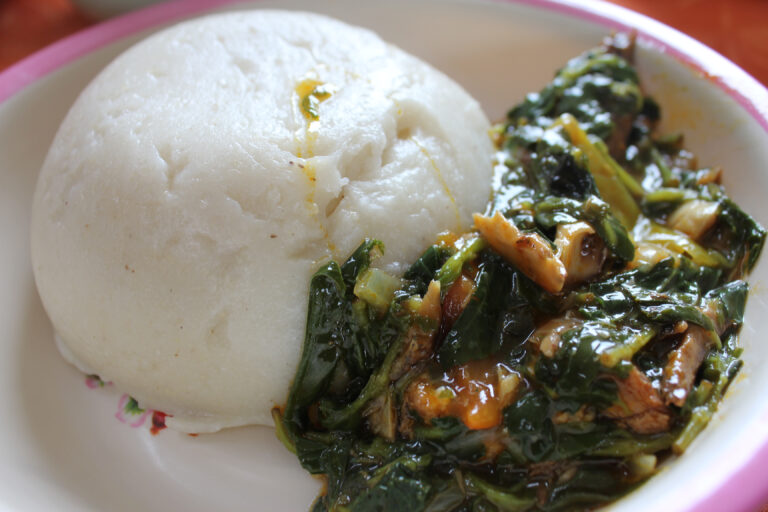Fufu, a staple food in Togo, is a dish that’s deeply woven into the fabric of the nation. It’s more than just sustenance—it’s a symbol of unity and tradition.
Our team at Remitly created this guide as part of our series that celebrates the traditional foods of our global customers.
Ingredients and Preparation
In Togo, fufu is often made from yams, but cassava is also widely used. The process usually involves boiling the chosen starchy vegetable until it becomes soft and then pounding it until a smooth, stretchy, dough-like consistency is achieved.
This is typically done using a large wooden mortar and pestle, often with two people working in tandem: one pounding and the other turning and moistening the fufu.
A Simple Yam Fufu Recipe
Fufu is a dish that’s easy to prepare with just a few ingredients. Here’s a basic recipe you can try at home.
Ingredients:
- 4 large yams
- Water for boiling
- Salt to taste
Instructions:
- Peel the yams and cut them into chunks.
- Place the yam chunks in a large pot, add enough water to cover them, and bring it to a boil.
- Cook until the yams are soft and easily pierced with a fork—this usually takes about 30 minutes.
- Drain the water and transfer the cooked yams to a mortar.
- Using a pestle, pound the yams until they form a smooth, stretchy dough. Add salt to taste during this process.
- Once you achieve the desired consistency, your fufu is ready to serve.
Remember, fufu is best enjoyed fresh and hot with your favorite soup or stew.
Variations of Fufu Across Togo
In Togo, variations in fufu preparation reflect the diversity within the country. In some regions, cornmeal replaces yams or cassava as the main ingredient—giving birth to akume—a variant loved for its slightly sweet flavor.
Other areas prefer plantain-based fufu which has a distinct tanginess that pairs well with spicy dishes. There are also numerous versions of this dish all over West Africa.
Serving and Eating Etiquette
Eating fufu is an experience steeped in tradition. It’s typically served hot alongside soup or stew in communal bowls promoting shared meals—an important aspect of Togolese culture.
Using your right hand, you tear a small piece of fufu, shape it into a ball, make an indentation with your thumb, and scoop up the soup or stew. This method of eating enhances the communal dining experience and fosters a sense of unity.
Popular Pairings
Fufu pairs well with various dishes due to its neutral flavor. In Togo, it’s often served with groundnut soup—a rich concoction made from peanuts, meat or fish, tomatoes, onions and spices.
Another popular pairing is palm nut soup—a hearty stew made from palm fruits that adds a unique depth to the taste experience when eaten with fufu.
The Origin of Fufu
Fufu, with its various names and forms, has deep roots in the culinary history of West Africa. Its origins can be traced back several centuries.
The word “fufu” is believed to have originated from the Twi language of the Akan ethnic group in Ghana, where it means “mash” or “mix.”
However, while Ghana can claim the name’s origins, the concept of pounding starchy foods into a dough-like consistency is a tradition shared by many West African cultures, even before the borders of present-day nations were established.
Historically, fufu’s beginnings are linked to the cultivation of starchy crops in West Africa, particularly yams. The yam holds deep cultural significance in regions of Nigeria and Ghana, and its cultivation can be traced back over 11,000 years.
As communities learned to farm yams and later cassava, which was introduced to Africa from South America in the 16th century, they also developed methods to process and store these crops. Pounding them into a smooth, stretchy consistency was not only a means of consumption but also a preservation method.
As West African communities traded, migrated, and interacted over time, variations of fufu spread throughout the region, with each community adapting it based on available ingredients and local preferences.
Togolese Cuisine: A Melting Pot of Flavors
Togo’s cuisine reflects its rich cultural diversity and history. It’s characterized by bold flavors, fresh ingredients, and an array of dishes that cater to different palates.
Staple Foods
Aside from fufu, other staple foods in Togo include maize, millet, sorghum, beans, rice, and cassava—all often used as bases for various dishes.
Popular Dishes
One popular dish is Djenkoume—a tomato-based cornmeal dumpling dish often served with meat or fish sauce. Another well-known meal is Akpan—a fermented corn or millet dough served with okra soup.
Grilled meat skewers known as brochettes are also favored street food items in Togo—often enjoyed with spicy sauces on the side.
Seafood Delights
Given its coastal location, seafood plays a significant role in Togolese cuisine. Fish, shrimp, and other seafood are often used in soups, stews, and grilled dishes.
Spices and Flavors
Togolese food is known for its robust flavors. Spices like ginger, garlic, nutmeg, and chili peppers are commonly used to add depth to dishes.
Palm oil—a richly flavored oil extracted from palm fruits—is also a key ingredient in many Togolese recipes.
Sweet Treats
For those with a sweet tooth, Togo offers treats like Akassa—a fermented corn pudding—and Klako—an airy cake made from fermented cassava.
Visit the homepage, download our app, or check out our Help Center to get started.
